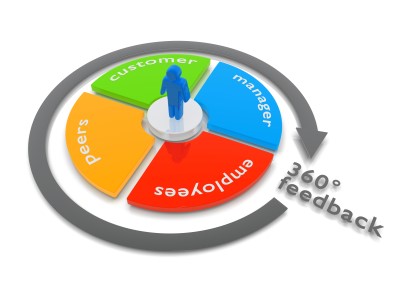 360 Degree Feedback
360 Degree Feedback
360 degree feedback is a performance appraisal method that gathers feedback on an individual from several sources. This measurement or appraisal requires that the employee’s productivity be evaluated by everyone they work or interact with daily, including those, above and below their job level. All evaluators must know and understand their co-worker’s overall role and function, daily work duties, professional credentials and communication skills.
To achieve best possible accuracy, employees must first receive training on how to offer input that is well-balanced and impartial. They must be trained to offer feedback that is based purely on their co-worker’s professional abilities, not on their personal feelings or beliefs about that employee.
Supporters of 360 feedback contend that this gives managers and individual’s better information about skills and performance, as well as working relationships, compared with more traditional appraisal arrangements based on line managers’ assessments. The fact that the feedback comes from several different sources eliminates any possible bias that could be present when only a single manager is involved.
The rationale for gathering 360 degree feedback is that, in large complex organisations, managers will not have a full understanding of the contribution of the people they manage, as they may be part of many different teams and engage in autonomous or semi-autonomous relationships with customers or colleagues. Gathering feedback on individuals from several sources ensures the feedback is wide-ranging information and will therefore provide a more accurate picture of the individual’s performance.
In 360 degree feedback, between 7 and 10 evaluators complete questionnaires or give structured feedback describing the performance of the individual under review. The evaluators represent different types of work relationships with the individual, hence the term ’360 degree’ feedback.
The 360 degree questionnaire will consists of a number of statements or questions designed to seek the evaluators thoughts on the competencies that the review intends to measure.
The evaluators rate the statements on a scale and include free text comments. The ensuing report should summarise the ratings given for each statement, as well as averages for each competency, and any written comments.
Before the review process begins, it’s important to establish a clear and consistent understanding of ’good’ performance across the organisation, as well as to ensure that the organisational culture enables individuals to give and receive feedback in a constructive manner.
The downside of using 360 Degree Feedback is that they can be complex to administer especially in a workplace with large numbers of employees. It becomes cumbersome and difficult to oversee the multitude of surveys involved in a true 360 Degree feedback initiative. These studies require each employee to have a separate set of questionnaires filled out by their co-workers and analysed individually. Also, the questions in each questionnaire will probably differ based on the position of the individual in the workplace.
